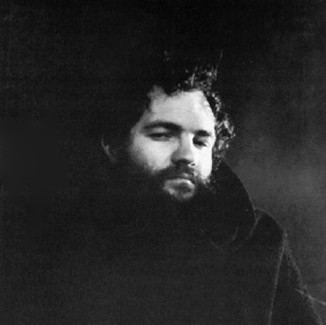> Studies > FAC-SIMILES > La Monte Young
LA MONTE YOUNG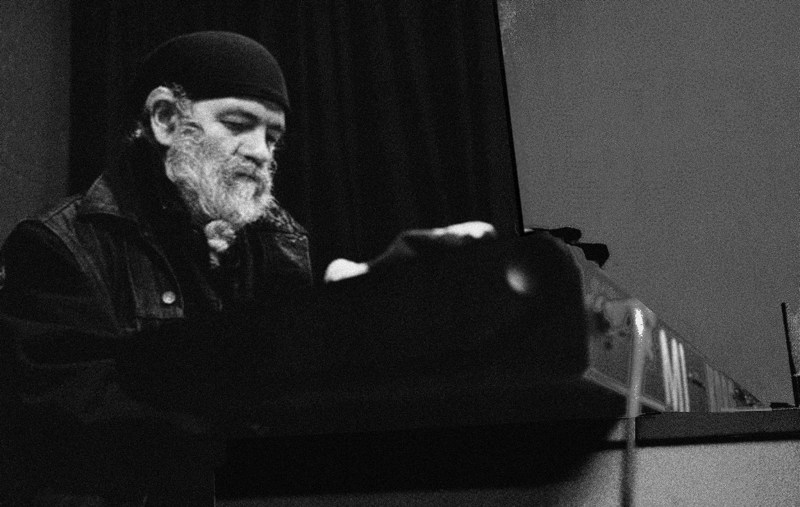
|
Articles connexes / Other Articles:
- LA MONTE YOUNG (Papers, articles) — lire/read
- LA MONTE YOUNG (Works) — lire/read
- LA MONTE YOUNG (Scores, writings) — Documentation
- LA MONTE YOUNG (Interview 2003) — lire/read
- POEM FOR CHAIRS, TABLES, BENCHES, ETC (La Monte Young) — lire/read
- X FOR HENRY FLINT (La Monte Young) — lire/read
- TWO SOUNDS (La Monte Young) — lire/read
- THE WELL-TUNED PIANO (La Monte Young) — lire/read
- BB DORIAN BLUES - TREE - YAM FESTIVAL (La Monte Young) — lire/read
- DREAM HOUSE, ETC (La Monte Young) — bientôt / soon
- Around La Monte Young : FLYNT, MACIUNAS — lire/read
- LA MONTE YOUNG — An Anthology of Chance Operations (1963) — Documentation
- LA MONTE YOUNG — Selected Writings (1959-1969) — Documentation
- ► WORKS : AudioVideo Files
- ► Just Charles & cello in The Romantic Chord (2002-2003)
- ► Dream House (1973)
- ► 31 VII 69 10:26 - 10:49 PM
- ► Oceans (1969)
- ► Drift Study 31 I 69 12:17:30 - 12:49:58 PM NYC (1969)
- ► Drift Study 4:37:40 - 5:09:50 - 4:37:40 PM — 5 VIII 68 NYC (1968)
- ► Bowed Mortar Relays (1966)
- ► The Well-Tuned Piano (1964/1973/1981/Present...)
- ► Studies in The Bowed Disc (1963)
- ► The Overday (1963)
- ► Bb Dorian Blues (1963)
- ► The Second Dream Of The High Tension Line Stepdown Transformer From the Four Dreams of China (1962)
- ► Poem for Chairs, Tables, Benches, etc. and Other Sources (1960)
- ► Forty-Two for Henry Flynt, for gong solo (X for Henry Flynt - 1960)
- ► Two Sounds (1960)
- ► Vision (1959)
- ► Trio for Strings (1958)
- ► Five Small Pieces for String Quartet (On Remembering a Naiad), for string quartet (1956)
- ► WORKS : List (1953-1985)
- ► WORKS : List (1985-2005)
WORKS : AudioVideo Files(Edit)
Just Charles & cello in The Romantic Chord (2002-2003)(Edit)
pour violoncelle, bourdonnements de violoncelle enregitré, et jeu de lumières.
“Just Charles and Cello in the Romantic Chord”, écrite pour le violoncelliste Charles Curtis et bourdons de violoncelle pré-enregistrés, est basée sur l’accord en intonation juste du même nom, déjà présent dans “The Well-Tuned piano”, composée en 1964. Les sons longuement prolongés, les rapports de fréquences périodiques, les petites irrégularités de coups d’archet dans les accords soutenus, exercent peu à peu sur l’auditeur des effets psycho-acoustiques et hypnotiques particuliers. L’odeur pénétrante de l’encens, l’environnement lumineux coloré très doux et la projection vidéo de Marian Zazeela - une calligraphie évoluant d’une manière subliminale - viennent prolonger ces sensations. — (Notes du programme Biennale Musiques en Scène, Lyon 2004)
Commande du : CCMIX (Centre de Creation Musicale Iannis Xenakis), Paris; Nouvelles Scenes/Le Consortium, Dijon; Musiques en Scene/Le Grame, Lyon; and MaerzMusik/Berliner Festspiele, Berlin.
Programmation live programming du violoncelle pré-enregistré : CCMIX, Stefan Tiedje, sous la direction de Charles Curtis et de La Monte Young
| Just Charles & cello in The Romantic Chord in a setting of abstract #1 from quadrilateral phase angle traversals in imagic light (cello, pre-recorded cello drone, and light design). The evening-long work, entitled Just Charles & Cello in The Romantic Chord in a setting of Abstract #1 from Quadrilateral Phase Angle Traversals with Dream Light, is composed for Charles Curtis, cello, pre-recorded cello drones and light design. First performed in Paris and Dijon in November-December 2003. Zazeela’s magenta and blue light design includes the projection of a calligraphic drawing programmed to gradually metamorphose in quadrilateral symmetry over the duration of the musical work. Much of Zazeela’s work in light and calligraphy has been grounded in concepts of structural symmetry. Abstract #1 from Quadrilateral Phase Angle Traversals is based on her Word Portraits series of drawings and neon sculptures in which she has presented names, words or ideas drawn with their bilaterally symmetrical, retrograde and mirror-inverted images, so that the abstract form of the written word may be viewed independently from its meaning. This allows the visual content of the work to be considered both apart from, and along with, the significance of the word. In Abstract #1, Zazeela turned this concept inside-out and created a pattern that is derived from and evocative of letter forms, but which does not generate known words. The projection becomes a mandala-like visual focus interweaving through time with the performance of the musical work. Composed in Just Intonation, which Young defines as “that system of tuning in which every frequency is related to every other frequency as the numerator or denominator of some whole number fraction,” "Just Charles & Cello in The Romantic Chord" is set in the Dorian mode. From the early ‘60s, the Dorian mode has been one of Young’s tonal resources, providing the basis for "Young’s Dorian Blues in G", which eventually became the singular work performed by his Forever Bad Blues Band, and for "The Romantic Chord", one of the major sections of his magnum opus, The Well-Tuned Piano. While the traditional tunings of the Dorian scale in just intonation are factorable by the primes 5, 3 and 2, Young’s tunings are unique in that the tuning for Young’s "Dorian Blues in G" is factorable by the primes 7, 5, 3 and 2, and the tuning for "The Romantic Chord" is factorable by 7, 3 and 2. As the title suggests, "Just Charles & Cello in The Romantic Chord" is based on the tuning of The Romantic Chord from The Well-Tuned Piano. Also in G, the Dorian mode of The Romantic Chord is based on the ascending Pythagorean series, C, G, D, A, E, with B-flat (the 3rd degree) and F (the 7th degree) derived septimally. The C, G, D and A are all open strings on the cello, the Pythagorean E exists as a natural harmonic on both the D and A strings, and the B-flat and F exist as natural harmonics on the C and G strings respectively. This congruence of pitches and strings delineates an inextricably inherent relationship between the tuning of the mode and the instrument. {small}The new work was composed specifically for Charles Curtis, who has studied the performance technique with Young in the guru-disciple method of oral transmission over a period of years. The work is not intended to be played by other cellists unless they study it with Young in the same way. "Just Charles & Cello in The Romantic Chord in a setting of Abstract #1 from Quadrilateral Phase Angle Traversals with Dream Light" was created under a commission from a consortium of four European organizations: CCMIX, Paris; Nouvelles Scenes/Le Consortium, Dijon; Musiques en Scene/Le Grame, Lyon; and MaerzMusik/Berliner Festspiele, Berlin. The commission was initiated by the CCMIX (Centre de Creation Musicale Iannis Xenakis) and its director, Gerard Pape. Utilizing pre-recorded cello samples played by Charles Curtis, the CCMIX realized a "live" computer part to facilitate real time manipulation of the cello drones. This program was written by Stefan Tiedje, musical assistant of the CCMIX, under the direction of La Monte Young and Charles Curtis, who was in residency at the CCMIX Paris in November for the realization of the program. The CCMIX is responsible for the sound production of the work for all of the world premiere performances in Europe. The first performances of Just Charles and Cello were maybe just shy of three hours, and little by little I was emboldened to play longer and push things and expand, and naturally that led to these discussions. But the main thing here is the intonation. La Monte himself, as a singer of raga, has unbelievably pure, exact intonation, and that's been the main substance in our work together over the years, working on just intonation. There are challenges of playing exactly in tune with prerecorded drones of sustained cello notes – in the case of the solo piece – and hitting them so that they meet with absolutely no interference or discrepancy. Obviously it's close to impossible. It's one of the things that La Monte's music is fundamentally about. The drones are actually played with a sine wave so that they are absolutely in tune, as a reference, a guide note. You don't hear the sine wave, but I'm playing with it to make sure I'm smack on, in the pre-recorded cello tones. In performance, these are played back in particular groupings of one note, two notes, 17 notes, etc., and I play all of this elaborate material in relation to those drones. In the earlier performances, my intonation was probably quite good, and there was an audible process of dialing it in (which can be very beautiful, listening to the performer bring the note right into focus and then holding it), which led to the performances being more restrained, because the process of searching for the pitches was more out in the open. You were hearing the searching, the looking for the notes. That led to another phase of more experimentation, more elaborate figuration and pattern. During the third phase of performances of the piece, I was rehearsing with La Monte as usual, and he was extremely encouraging, saying, your intonation is so good now that you're not searching for these notes, you're finding them. It was kind of a breakthrough, which I took to mean something a little bit like, this piece is now becoming yours, and you can go on with it. You are becoming one with the piece. — (Charles Curtis, 2010) Sources : http://www.melafoundation.org/paris_2003.htm http://www.melafoundation.org/justcharles_2004.htm http://www.melafoundation.org/cc.htm http://www.paristransatlantic.com/magazine/interviews/curtis.html http://www.diapasongallery.org/archive/2005/05-10.html |
|
LA MONTE YOUNG JUST CHARLES & CELLO IN THE ROMANTIC CHORD (2002-2003) (excerpt 15mn, unofficial live recording gleaned on the web) |
- Performances :
- Théâtre Molière - Maison de la Poésie, Paris, 16 & 19 nov 2003
- Théâtre du Parvis Saint Jean, Dijon, 5 dec 2003
- Festival Les Subsistances, Biennale Musiques en Scène, Lyon, 17 mar 2004 — programme
- Haus der Berliner Festspiele, MaerzMusik 2004, Festival für aktuelle Musik, Berlin, 22 mar 2004 — programme
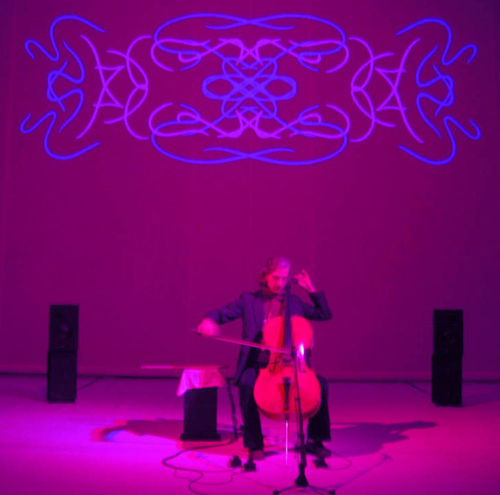 Charles Curtis, Dijon (F) — Photo by Uli Schaegger, 2004. |
Dream House (1973)(Edit)
13 I 73 5:35 - 6:14:03 PM NYC est une partie de "Map of 49's Dream The Two Systems of Eleven Sets of Galactic Intervals Ornamental Lightyears Tracery" , elle-même une section d'un travail encore plus vaste appelé "The Tortoise, His Dreams and Journeys" (la tortue, ses rêves et voyages). Dans ce document, trois générateurs d'ondes sinusoïdales et les membres du Théâtre de Eternal Music jouent ensemble.
| 13 1 73 5:35 - 6:14:03 PM NYC — sub-section of "Map Of 49's Dream The Two Systems Of Eleven Sets Of Galactic Intervals Ornamental Lightyears Tracery", begun in 1966 as a section of the even longer work: "The Tortoise, His Dreams And Journeys" which was begun in 1964 with The Theatre Of Eternal Music. Performed 13 January 1973 at La Monte Young's private studio. {small}Personnel: The Theater of Eternal Music ; La Monte Young - Voice and Sine Waves ; Marian Zazeela - Voice ; Jon Hassell - Trumpet ; Garrett List - Trombone — Source : released on the French label Shandar (1974) |
|
13 I 73 5:35 - 6:14:03 PM NYC Drift Study 14 VII 73 9:27:27-10:06:41 PM NYC |
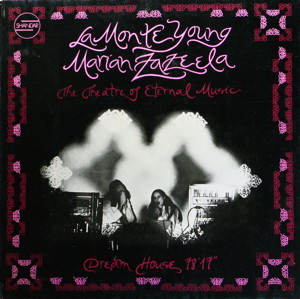 | 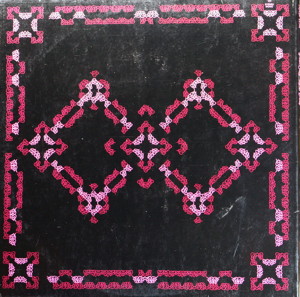 |
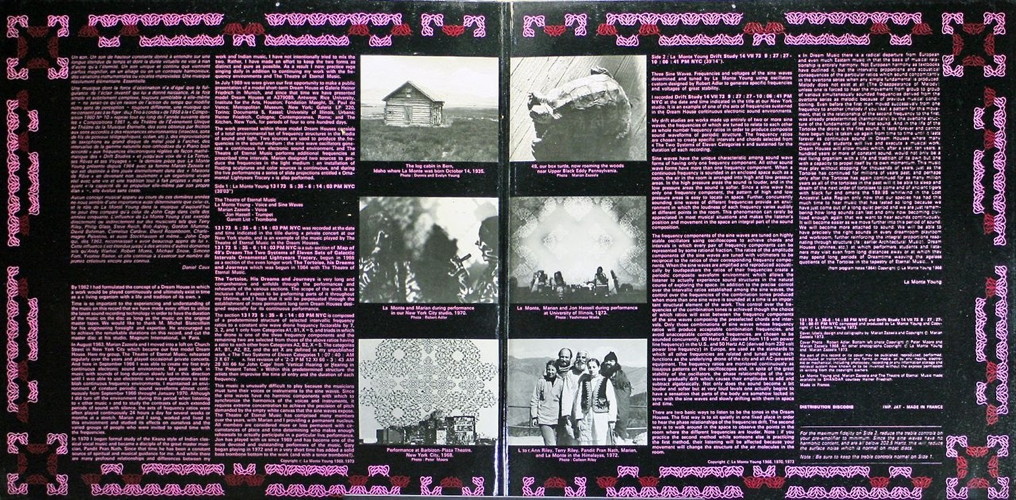 |
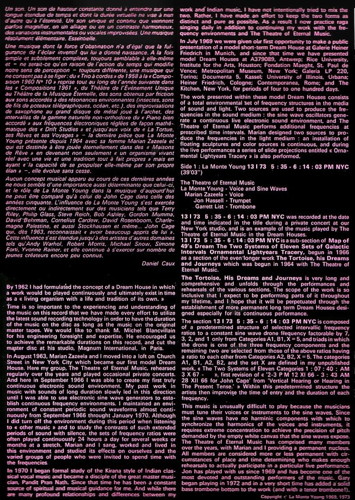 | 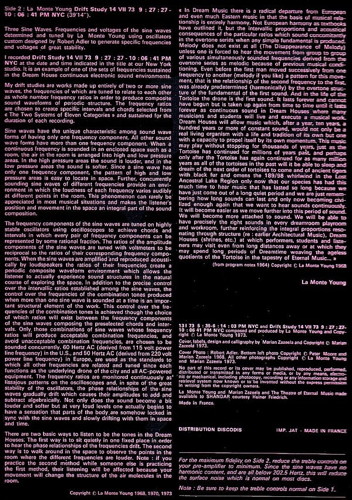 |
Drift Study 14 VII 73 9:27:27-10:06:41 PM NYC, se joue entièrement sur des générateurs d'ondes sinusoïdales. La fréquence et la tension électrique des ondes sinusoïdales ont été déterminées et accordées par La Monte Young utilisant pour cela des oscillateurs sur mesure conçus par l'ingénieur du son Robert Adler pour générer des fréquences spécifiques et des tensions électriques de grande stabilité. Les ondes sinusoïdales produites sont telles qu'elles interfèrent les unes avec les autres, créant ainsi des changements de volume à la fois dans le temps et dans l'espace qui peuvent être expérimentés soit en marchant dans la salle ou en restant sur place. Si l'on choisit de marcher, on va changer l'expérience sonore des autres personnes dans la pièce.
| On B-side on the vinyl : Drift Study 14 VII 73 9:27:27 - 10:06:41 PM NYC — Three sine waves. Frequencies and voltages of the sine waves determined and tuned by La Monte Young using oscillators custom designed by Rober Adler to generate specific frequencies and voltages of great stability. Performed 14 July 1973 at La Monte Young's private studio. (See Drift Study 1969 below) |
| My drift studies are works made up entirely of two or more sine waves, the frequencies of which are tuned to relate to each other as whole number frequency ratios in order to produce composite sound waveforms of periodic structure. The frequency ratios are chosen to create specific intervals and chords selected from «The Two Systems of Eleven Categories» and sustained for the duration of each recording. Sine waves have the unique characteristic among sound wave forms of having only one frequency component. All other sound wave forms have more than one frequency component. When a continuous frequency is sounded in an enclosed space such as a room, the air in the room is arranged into high and low pressure areas. In the high pressure areas the sound is louder, and in the low pressure areas the sound is softer. Since a sine wave has only one frequency component, the pattern of high and low pressure areas is easy to locate in space. Further, concurrently sounding sine waves of different frequencies provide an environment in which the loudness of each frequency varies audibly at different points in the room. This phenomenon can rarely be appreciated in most musical situations and makes the listener's position and movement in the space an integral part of the sound composition. The frequency components of the sine waves are tuned on highly stable oscillators using oscilloscopes to achieve chords and intervals in which every pair of frequency components can be represented by some rational fraction. The ratios of the amplitude components of the sine waves are tuned with voltmeters to be reciprocal to the ratios of their corresponding frequency components. When the sine waves are amplified and reproduced acoustically by loudspeakers the ratios of their frequencies create a periodic composite waveform environment which allows the listener to actually experience sound structures in the natural course of exploring the space. In addition to the precise control over the intervallic ratios established among the sine waves, the control over the frequencies of the combination tones produced when more than one sine wave is sounded at a time is an important structural element of the work. This control over the frequencies of the combination tones is achieved though the choice of which ratios will exist between the frequency components of the sine waves composing the preselected chords and intervals. Only, those combinations of sine waves whose frequency ratios will produce acceptable combination frequencies, and avoid unacceptable combination frequencies, are chosen to be sounded concurrently. 60 Hertz AC (derived from 115 volt power line frequency) in the U.S., and 50 Hertz AC (derived from 220 volt power line frequency) in Europe, are used as the standards to which all other frequencies are related and tuned since each functions as the underlying drone of the city and all AC-powered equipment. The frequency ratios are monitored continuously as lissajous patterns on the oscilloscopes and, in spite of the great stability of the oscillators, the phase relationships of the sine waves gradually drift which causes their amplitudes to add and subtract algebraically. Not only does the sound become a bit louder and softer but at very loud levels one actually begins to have a sensation that parts of the body are somehow locked in sync with the sine waves and slowly drifting with them in space and time. There are two basic ways to listen to be the tones in the Dream Houses. The first way is to sit quietly in one fixed place in order to hear the phase relationships of the frequencies drift, The second way is to walk around in the space to observe the points in the room where the different frequencies are louder. Note: if you practice the second method while someone else is practicing the first method, their listening will be affected because your movement will change the structure of the air molecules in the room. — La Monte Young |
31 VII 69 10:26 - 10:49 PM(Edit)
- 31 VII 69 10:26 - 10:49 PM :
This work was recorded at the date and time indicated in the title, at Galerie Heiner Friedrich, München 31 VII 69 10:26-10:49 PM - is a section of the longer work: "Map Of 49's Dream The Two Systems Of Eleven Sets Of Galactic Intervals Ornamental Lightyears Tracery". This performance is by La Monte Young and Marian Zazeela : Voice, Electronics [Sine Wave Drone] – La Monte Young ; Voice – Marian Zazeela
Source : http://archive.org/details/AM_1972_03_16
Officially released on 2800 copy limited edition LP “The Black Record” Edition X - Heiner Friedrich - Munich, Germany Recorded at the Galerie Heiner Friedrich in Munich, Germany.
|
31 VII 69 10:26 - 10:49 PM |
Oceans (1969)(Edit)
Issued from an aborted session for a 1969 CBS lp.
A recording (done by David Tudor) of Young and his collaborator/partner Marian Zazeela overlapping their voices in a series of reedy, mesmerizing drones as they sit on the edge of an ocean, over the sound of waves crashing against the shore.. In between extended passages of vocalizing, there are disarmingly mundane asides muttered by Young to Tudor about the minutiae of microphones. — Source : http://shadesofeternalnight.tumblr.com/page/2
|
OCEANS (1969) (unofficial live recording gleaned on the web) |
Drift Study 31 I 69 12:17:30 - 12:49:58 PM NYC (1969)(Edit)
| Drift Studies (1967- ) for two or more ultra-stable, precisely-tuned sine-wave drones. The recorded version offers a whole range of psychoacoustical effects to the armchair listener. In time, however, the pitches will 'drift' slightly, despite the accuracy of the equipment. Among other things this causes the volume of each pitch to drift as well. Between September 1966 and January 1970 Young had turned his house into a continuous sound environment. He consequently studied the effects in great detail. — Dave Smith, "Following a Straight Line: La Monte Young", Originally published in Contact no. 18 (Winter 1977-78), pp. 4-9. — http://www.users.waitrose.com/~chobbs/smithyoung.html |
"Drift Study" est basée sur une recherche attentive et contrôlée de l'incidence de la diffusion de fréquences dans un espace. L'œuvre repose sur le fait que les ondes sinus possèdent la caractéristique unique d'avoir qu'une seule frréquence (pure) alors que tous les autres sons sont composés de multiples fréquences (ou fréquences complexes). Lorsqu'une fréquence continue est diffusée dans un espace fermé, elle divise l'air dans cet espace en des zones de haute et de basse pression. Parce que l'onde sinus a une structure simple, ces zones sont aisément perçues et localisées dans l'espace par les auditeurs surtout lorsque ces derniers se déplacent. Pour La Monte Young, le principe de "Drift Study" était simple : "Ce phénomène est rarement perçu dans la plupart des situations musicales et il place la position et le mouvement de l'auditeur comme partie intégrante de la composition". Un auditeur "passif" (ou immobile) ne percevrait qu'une seule fréquence stable et constante. Un auditeur "actif" mobile dans l'espace découvre une variété de variations générées à partir de la monotonie invariante d'une fréquence.
Performed by La Monte Young : Sine-Wave Drone.
Officially released on LP Aspen Magazine Issue No. 8 - NYC 1969
|
DRIFT STUDY 31 1 69 12-17-33 (Excerpt) |
Drift Study 4:37:40 - 5:09:50 - 4:37:40 PM — 5 VIII 68 NYC (1968)(Edit)
(25' Excerpt)
Tape realization for SMS (Super Monolograph Series) magazine nr4 (5' reel-to-reel audio tape, 1968 ; reissued on cassette, 1988). Frequency and amplitude ratios tuned by the composer on a Moog synthesizer utilizing its sine wave oscillators, mixer and lowpass filter.
Recorded in NYC for Roaring Fork Press
|
DRIFT STUDY 4:37:40 - 5:09:50 - 4:37:40 PM — 5 VIII 68 NYC (Excerpt) |
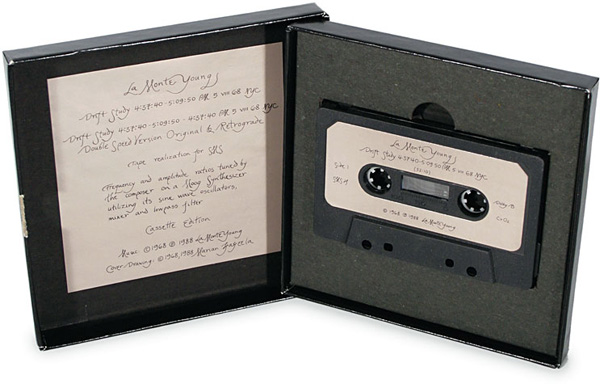
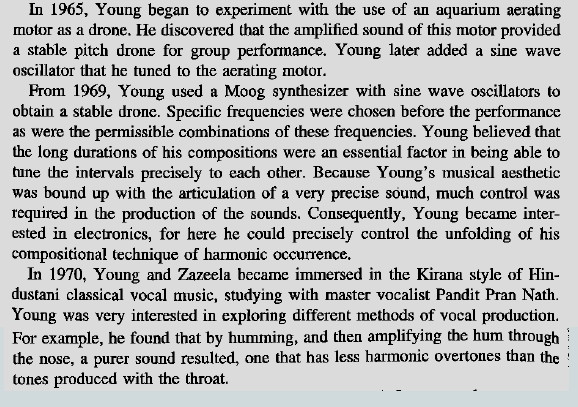 | Ruth Lee Martin,, 'La Monte Young'. In Music of the avant-garde. New York : Greenwood Press, 2002 |
Bowed Mortar Relays (1966)(Edit)
- Bowed Mortar Relays (Soundtracks and scores for Andy Warhol Films : "Eat," "Sleep," "Kiss," "Haircut"), tape :
"Bowed Mortar Relays" is based on realization of "Composition 1960 # 9" : Composition 1960 #9 (October 1960) was a straight line drawn on a file card (The enclosed score is right side up when the line is horizontal and slightly above center),
When Warhol was invited to show four films at the 1964 New York Film Festival, he commissioned La Monte Young to compose a taped soundtrack that could be used for all four - the droning sound of a bow being played over a brass mortar. Now that Warhol turns the camera off and on during a sequence, he does it without regard for what the performers are saying, so that dialogue is arbitrarily punctuated and blipped without concern for content.
Early performances of Compositions 1960 #9 included presenting for the audience the faint but audible hum of Richard Maxfield's tape recorder, sustaining a single note for an extended period, and bowing a brass mortar. [...] The recording of the bowed mortar version of #9 never actually accompanied the films in a public screening.
As part of the New York Film Festival in September 1964, and while a sound check prior to the Warhol films' premiere, that La Monte composed for, the theatre director “demanded” the music be turned down to “reasonable” levels. La Monte would not allow it and rather then compromise his music by changing the volume, he withdrew the music from the movies.
Sources :
— Mark Alburger, "La Monte Young: Compositions 1961" 21st Century Music 10, no. 4 (April 2003).
— In M. Musick, "La Monte Young", april 2008
— In Jeremy Grimshaw, "Draw a Straight Line and Follow It : The Music and Mysticism of La Monte Young", Oxford University Press, 2011, p. 81 & 205
- Andy Warhol : "Eat", (1963, 39mn30), http://www.youtube.com/watch?v=XoQcGAczNTE , http://www.warholstars.org/filmch/Eat.html
- Andy Warhol : "Sleep", (1963, 5h21mn), http://vimeo.com/4880378 , http://www.warholstars.org/filmch/sleep.html
- Andy Warhol : "Kiss", (1963, 54mn), http://www.youtube.com/watch?v=FmzqNUaCGQU , http://www.warholstars.org/chron/1963.html#kiss
- Andy Warhol : "Haircut", (1963, 27mn), http://www.warholstars.org/filmch/haircut.html
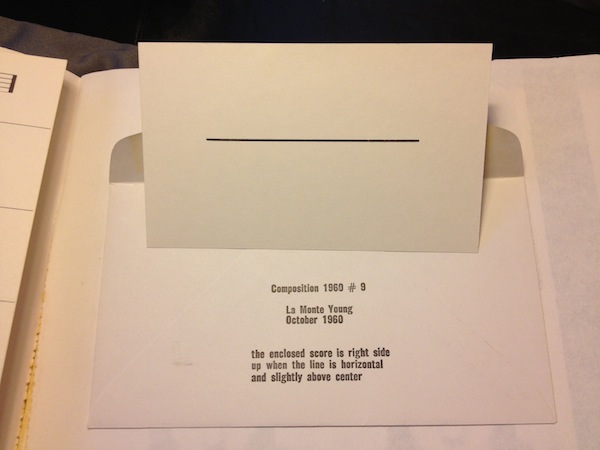
The Well-Tuned Piano (1964/1973/1981/Present...)(Edit)
Performed by La Monte Young in a setting of The Magenta Lights by Marian Zazeela. Recorded live at the last 6 Harrison Street Dream House concert of The Well Tuned Piano, New York City on October, 25, 1981, from 6.17.50 to 11.18.59 PM. 1981 version "The Elysian Fields".
Performed by La Monte Young : Just Intonation Boesendorfer Piano
- — lire l'article et accès à la vidéo d'une performance de The Well Tuned Piano (87 V 10 6:43:00 PM – 87 V 10 01:07:45 AM NYC)
- — continue reading and play the video of a performance of The Well Tuned Piano (87 V 10 6:43:00 PM – 87 V 10 01:07:45 AM NYC)
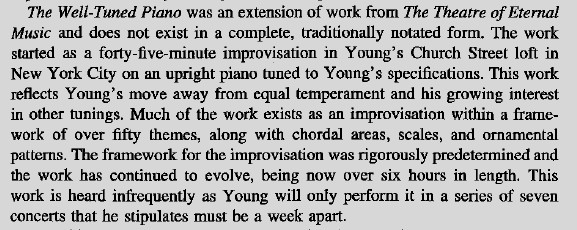 | Ruth Lee Martin,, 'La Monte Young'. In Music of the avant-garde. New York : Greenwood Press, 2002 |
Studies in The Bowed Disc (1963)(Edit)
- La Monte Young’s Eternal Music — 23 VIII 64 2:50:45-3:11AM, the volga delta (from Studies in The Bowed Disc) :
"23 VIII 64 2:50:45-3:11AM, the volga delta" (from Studies in The Bowed Disc).
We recorded this gong duet in our studio in New York City on the date and time indicated in the title. It is a section of a larger work: Studies In The Bowed Disc begun in September 1963. To listen to the live performance, playback at 33 1/3 rpm. However, this side may be played back at any slower constant speed down to 8 1/3 rpm, i.e., 16 2/3 rpm which is available on some turntables.
These performances are by La Monte Young and Marian Zazeela : Gong [Bowed] – La Monte Young , Marian Zazeela
Source : http://archive.org/details/AM_1972_03_16
Officially released on 2800 copy limited edition LP “The Black Record” Edition X - Heiner Friedrich - Munich, Germany. Recorded in New York City.
|
31 VII 69 10:26 - 10:49 PM, from Studies In The Bowed Disc |
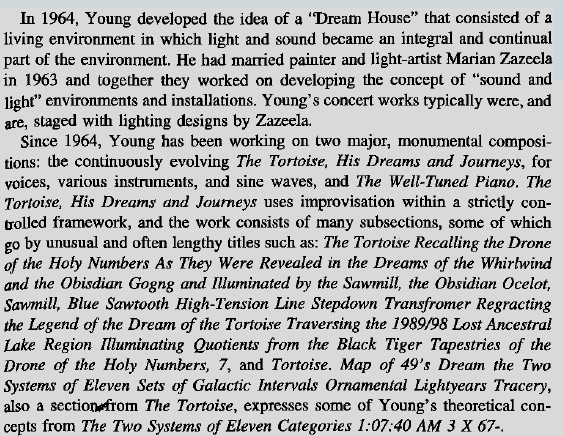 | Ruth Lee Martin,, 'La Monte Young'. In Music of the avant-garde. New York : Greenwood Press, 2002 |
The Overday (1963)(Edit)
Improvisations 1962-1964 - sopranino saxophone (w/ drones & various instruments) : Bb Dorian Blues, The Overday, Early Tuesday Morning Blues, Sunday Morning Blues
28 XI 63 - The Overday.
Performed by The Theatre of Eternal Music : La Monte Young : Sopranino Saxophone ; Marian Zazeela : Voice Drone ; Angus MacLise : Hand Percussion ; Tony Conrad : Bowed Guitar ; John Cale : Viola
This piece was aired during the October 21, 1984 WKCR (89.9 FM) 24 Hour La Monte Young Retrospective radio broadcast in celebration of La Monte Young’s 49th birthday from Columbia University.
This has been remastered, balanced and pitch-corrected to the drone note of Ab, in order for the sopranino saxophone to be playing as indicated by the following statement made by La Monte Young in his online essay “Notes on The Theatre of Eternal Music and The Tortoise, His Dreams and Journeys”
| "The specific rules that governed the performance of my music, including the sections of "The Tortoise, His Dreams and Journeys" participated in by Tony Conrad and John Cale, create a sound characterized by the predominance of musical intervals whose numerators and denominators in just intonation are factorable by the primes 7, 3, and 2, and selected higher primes, especially 31, and by the exclusion of intervals whose numerators and denominators are factorable by the prime 5. If we represent intervals with numerators and denominators factorable by the primes 7, 3, and 2 in conventional music notation and terminology, we obtain intervals that include various sized major and minor sevenths (with emphasis on the septimally derived blues minor seventh in my compositions such as "Bb Dorian Blues", "Early Tuesday Morning Blues", "Sunday Morning Blues", and "The Tortoise"), perfect fifths, octaves, unisons and their inversions, various sized major and minor seconds, and perfect fourths. The blues I was playing on the sopranino saxophone, directly preceding the period of The Tortoise, emphasized a technique I invented consisting of extremely fast combination permutations of a limited set of tones to simulate a sustained chord. And the chord I increasingly emphasized consisted of the pitches Eb, Bb, Db, Eb, (the IV-chord from Bb Dorian Blues) extended over the full range of the saxophone. Translated back into just intonation, these pitches are all examples of octave transpositions of the primes 7, 3, and 2." — (La Monte Young, http://melafoundation.org/theatre.pdf ) |
|
LA MONTE YOUNG (improvisations 1962-1964) 28 XI 63 - THE OVERDAY (Excerpt / part of an 80-minute session) dur. 20mn |
Bb Dorian Blues (1963)(Edit)
Improvisations 1962-1964 - sopranino saxophone (w/ drones & various instruments) : Bb Dorian Blues, The Overday, Early Tuesday Morning Blues, Sunday Morning Blues
|
LA MONTE YOUNG (improvisations 1962-1964) 19 X 63 - B FLAT DORIAN BLUES (excerpt) (Recorded by La Monte Young and the Theater Of Eternal Music on October 19th, 1963) |
B♭ Dorian Blues Saturday 19th October 1963 - 5th Day Of The Hammer
Drums [Hand] : Angus MacLise — Guitar [Bowed] : Tony Conrad — Sopranino Saxophone : La Monte Young — Viola : John Cale — Vocals [Drone] : Marian Zazeela
Comments on another variation "Dorian Blues in G"
Young's "Dorian Blues in G", captured for posterity on Just Stompin': Live at the Kitchen (Gramavision). It's an intensely physical, two-hour-long piece that transfigures blues progressions and through use of his "just intonation" system (which forsakes conventional "equal-tempered" notation in favor of a 49-notes-to- the-octave system) creates a listening environment that's totally unique and surprisingly easy to grasp. — (David Sprague, In Request magazine)
Between the concept and its actual execution, there's a mass of theory and application that rivals quantum physics in complexity. But you don't need to understand it to love Young's "Dorian Blues in G", a piece in which each chord of a six-chord progression gets a 20-minute workout. The unusual harmonies produced through just intonation are invigorating; they resonate in the heart and soul besides ringing in your ears. Young's blues are unlike any you've heard before, and at the same time they're as pure a musical illumination of the form as you're ever likely to hear. — (Glenn Kenny, In Spin magazine)
Listening to Young's "Dorian Blues in G" the sole, two-hour piece in the band's repertoire I'm filled with the same urgent, excited feeling I felt when I first heard something as agonizingly beautiful as Robert Johnson's "Stones in My Passway." Only Young is approaching blues from the other side, the top side, where harmonic theory and microtonal minutiae are the gates that free the flow of emotion. Partly due to Young's mathematical and compositional precision, his grasp of the real meaning of musical intervals, his deeply ingrained spirituality and romanticism, and his coherence to the universal truth of sound, there's a beauty in the piece that goes beyond math, beyond the blues, and beyond music. — (Neil Strauss, New York Press)
— Sources :
— http://www.melafoundation.org/fbbpress.htm
— http://www.dbdoty.com/Words/LMYInterview_01.html
— http://home.cogeco.ca/~lamonteyoung/63X19_5TH_DAY_OF_THE_HAMMER_Bb_DORIAN_BLUES.htm
The Second Dream Of The High Tension Line Stepdown Transformer From the Four Dreams of China (1962)(Edit)
The Tortoise, His Dreams and Journeys
day of the unquiet grave smoke of the shore (December 10 - 11, 1962). Performed by The Theatre of Eternal Music Brass Ensemble . Live at Merkin Hall, New York City, New York April 1993. 8 Trumpets with Harmon Mutes :
Trumpet — Ben Neill (leader), Gary Trosclair, (Chuck Olsen), James Donato, James O'Connor, Pamela Fleming, Rich Clymer, Rich Kelley, Stephen Burns
(La vidéo documentaire n'est plus accessible sur Youtube / The video document is not yet available on Youtube)
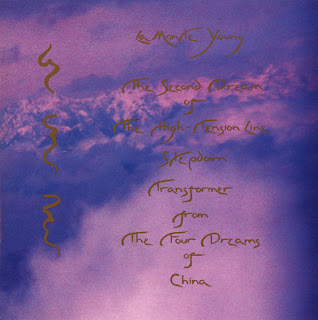 | 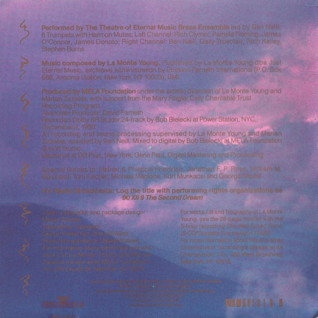 |
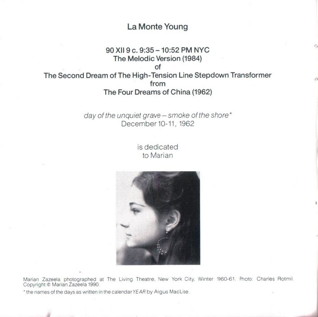 |  |
 | 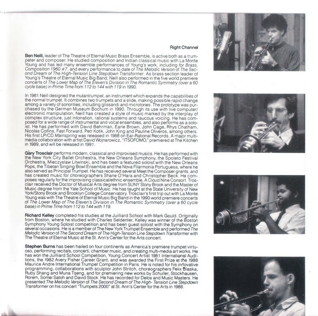 |
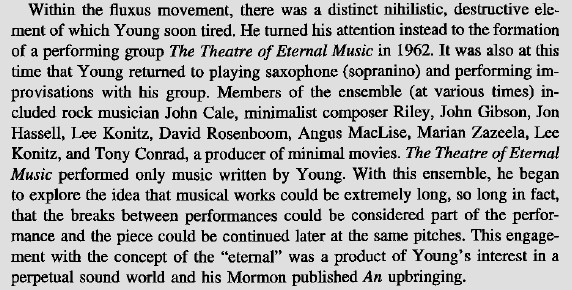 | Ruth Lee Martin,, 'La Monte Young'. In Music of the avant-garde. New York : Greenwood Press, 2002 |
 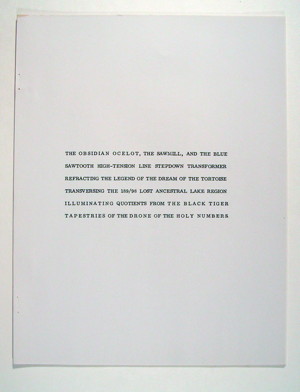  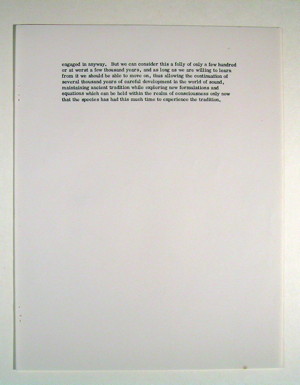 | Theatre of Eternal Music The Tortoise, His Dreams and Journeys or The Obsidian Ocelot, The Sawmill, and the Blue Sawtooth High-Tension Line Stepdown Transformer Refracting the Legend of the Dream of the Tortoise Transversing the 189/98 Lost Ancestral Lake Region Illuminating Quotients from the Black Tiger Tapestries of the Drone of the Holy Numbers Programme concert 25 Feb 1965 (rather : performances of the end of November and beginning of December 1964) The East End Theatre NYC La Monte Young (Voice Drone) Marian Zazeela (Voice Drone, Stage and Set Designer) Tony Conrad (Violin) John Cale (4 String Drone) — Source : http://pastelegram.org/features/282/event/692 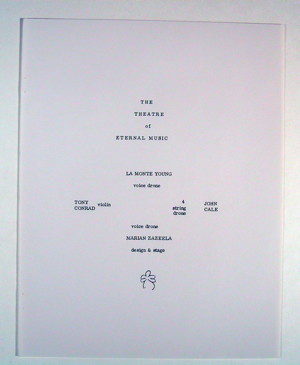 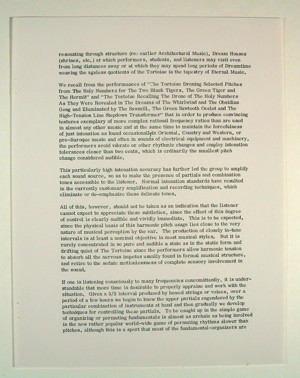 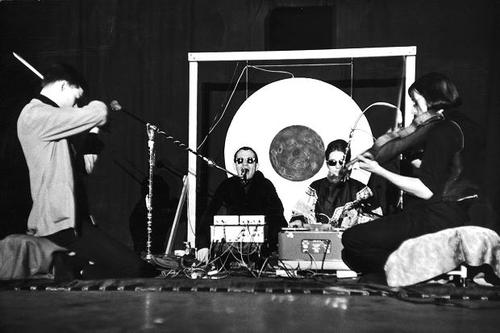 |
| The American Theatre for Poets, Inc. presents The Theatre of Eternal Music at The East End Theatre 85 East 4th Street New York City 25 Feb. 1965 — (rather : 21&22&23 Nov. 1964 and 12&13 Dec. 1964) The Theatre of Eternal Music La Monte Young, voice drone ; Marian Zazeela, voice drone, design & stage ; Tony Conrad, violin ; John Cale, 4 string drone Welcome to this presentation of Dream Music. We are pleased to be continuing our performance of "The Tortoise, His Dreams and Journeys". In "The Obsidian Ocelot, The Sawmill, and The Blue Sawtooth High-Tension LIne Stepdown Transformer Refracting The Legend of The Dream of The Tortoise Traversing the 189/98 Lost Ancestral Lake Region Illuminating Quotients from The Black Tiger Tapestries of The Drone of The Holy Numbers, " we have chosen to demonstrate only a select group of pitches which are found in the structure of the overtone series of bowed strings and vocal cords. In Dream Music there is a radical departure from European and even much Eastern music in that the basis of musical relationship is entirely harmony. Not European harmony as textbooks have outlined it, but the intervallic proportions and acoustical consequences of the particular ratios which sound concomitantly in the overtone series when any simple fundamental is produced. Melody does not exist at all (The Disappearance of Melody) unless one is forced to hear the movement from group to group of various simultaneously sounded frequencies derived from the overtone series as melodic because of previous musical conditioning. Even before the first man moved successively from one frequency to another (melody if you like) a pattern for this movement, that is the relationship of the second frequency was already predetermined (harmonically) by the overtone structure of the fundamental of the first sound. And in the life of the Tortoise the drone is the first sound. It lasts forever and cannot have begun but is taken up again from time to time until it lasts forever as continuous sound in Dream Houses where many musicians and students will live and execute a musical work. Dream Houses will allow music which, after a year, ten years, a hundred years or more of constant sound, would not only be a real living organism with a life and tradition all its own but one with a capacity to propel itself by its own momentum. This music may play without stopping for thousands of years, just as the Tortoise has continued for millions of years past, and perhaps only after the Tortoise has again continued for as many million years as all of the tortoises in the past will it be able to sleep and dream of the next order of tortoises to come and of ancient tigers with black fur and omens the 189/98 whirlwind in the Ancestral Lake Region only now that our species has had this much time to hear music that has lasted so long because we have just come out of a long quiet period and we are Just remembering how long sounds can last and only now becoming civilized enough again that we want to hear sounds continuously. It will become easier as we move further into this period of sound. We will become more attached to sound. We will be able to have precisely the right sounds in every dreamroom playroom and workroom, further reinforcing the whole numer integer (integral) proportions resonating through structure (re: earlier Architectural Music), Dream Houses (shrines, etc.) at which performers, students, and listeners may visit even from long distances away or at which they may spend long periods of Dreamtime weaving the ageless quotients of the Tortoise in the tapestry of Eternal Music. We recall from the performances of "The Tortoise Droning Selected Pitches from The Holy Numbers for the Two, Black Tigers, The Green Tiger, and the Hermit" and "The Tortoise Recalling the Drone of the Holy Numbers As They Were Revealed in The Dreams of the Whirlwind and The Obsidian Gong and Illuminated by the Sawmil, The Green Sawtooth Ocelot and The High-Tension Line Stepdown Transformer" that in order to produce convincing textures exemplary of more complex rational frequency ratios than are used in almost any other music and at the same time to maintain the forcefulness of just intonation as found occasionnaly in Oriental, Country and Western, or pre-Baroque music and often in sounds of electrical equipment and machinery, the performers avoid vibrato or other rythmic changes and employ intonation tolerances closer than two cents, which is ordinarily the smallest pitch change considered audible. This particularly high intonation accuracy has further led the group to amplify each sound source, so as to make the presence of partials and combination tones accessible to the listener. Normal intonation standards have resulted in the currently customary amplification and recording techniques, which eliminate or de-emphasize these delicate tones. All of this, however, should not be taken as an indication that the listener cannot expect to appreciate these subtleties, since the effect of this degree of control is clearly audible and vividly immediate. This is to be expected, since the physical basis of this harmonic pitch usage lies close to the very nature of musical perception by the ear. The production of closely in-tune intervals is at least a nominal objective in most musical styles. But it is rarely concentrated in so pure and audible as state as in the static form and drifting quiet of The Tortoise since the performers allow harmonic tension to absorb all the nervous impetus usually found in formal musical structure, and retire to the sedate motionlessness of complete sensory involvement in the sound. If one is listening consciously to many frequencies concomittantly, it is understandable that more time is desirable to properly appraise and work with the situation. Given a 3/2 interval produced by bowed strings or voices, over a period of few hours we begin to know the upper partials engendered by the particular combination of instruments at hand and then gradually we develop techniques for controlling these partials. To be caught up in the simple game of organizing or permuting fundamentals is almost as archaic as being involved in the now rather popular world-wide game of permuting rhythms slower than pitches, although this is a sport that most of the fundamental-organizers are engaged in anyway. But we can concsider this a folly of only a few hundred or at worst a few thousand years, and as long as we are willing to learn from it we should be able to move on, thus allowing the continuation of several thousand years of careful development in the world of sound, maintaining ancient tradition while exploring new formulations and equations which can be held within the realm of consciousness only now that the species has had this much time to experience the tradition. |
Forty-Two for Henry Flynt, for gong solo (X for Henry Flynt - 1960)(Edit)
Performed by Peter Winkler (gong) at the Third Annual Festival of the Avant Garde in San Francisco, 1965
X For Henry Flynt (1960) — Il s'agit d'une pièce dans laquelle l'interprète doit répéter toutes les une à deux secondes un son relativement puissant, un grand nombre de fois. Le X correspond au nombre d'itérations, qui n'est pas spécifié — (Le nombre 566 semble néanmoins un choix en vogue depuis la création de la pièce en mai 1961 par Toshi Ichiyanagi. Voir Henry Flynt, « La Monte Young in New York, 1960-62 ».)
Recorded and broadcast by KPFA radio.
- — Écoutez un extrait audio / Listen to an audio excerpt
— Source : http://archive.org/details/42forHenryFlynt
Two Sounds (1960)(Edit)
"One further composition reached England in 1964 when the Merce Cunningham Dance Company were at Sadler's Wells and the Phoenix Theatre for a season. Cunningham had choreographed a composition called 2 Sounds. The composer had provided two sounds on separate tapes, to be started at different points during the ballet. When the first sound starts you cannot imagine that any more horrible sound exists in the whole world. Then the second sound comes in and you have to admit you were wrong." — Cornelius Cardew
2 Sounds (1960) dates from a period of close collaboration with Terry Riley. One sound is made by scraping a tin can over a pane of glass, the other by scraping a drum stick around a gong: both tin and gong were close-miked. The sounds were recorded on separate tapes which are started at different times. Merce Cunningham has been using this version for his 'Winterbranch' ballet since 1964.
— Dave Smith, "Following a Straight Line: La Monte Young", Originally published in Contact no. 18 (Winter 1977-78), pp. 4-9. — http://www.users.waitrose.com/~chobbs/smithyoung.html
Performed by : La Monte Young : Drumstick on Gong ; La Monte Young and Terry Riley : Cans on Windows.
Recorded in April 1960. Location unknown.
Used by the Merce Cunningham Dance Company for the Winterbranch ballet since 1964.
Vision (1959)(Edit)
pour piano, 2 cuivres, flûte à bec, 4 bassons, violon, alto, violoncelle, contrebasse.
| "Vision" (1959) is a music work for twelve instrumentalists playing unconventional sounds within the space of thirteen minutes, as determined by chance operations. "Vision" (12 November 1959) consists, according to its composer, 'entirely of unconventional sounds articulated on conventional instruments'.  Henry Flynt, "La Monte Young in New York 1960-62", In "Sound and Light : La Monte Young Marian Zazeela", edited by William Duckworth and Richard Fleming, Bucknell Review, A Scholarly Journal of Letters, Arts, and Sciences, Bucknell University, Lewisburg, PA, Associated University Presses, 1996, p. 49  Ruth Lee Martin, "La Monte Young", In Larry Sitsky, "Music of the Twentieth-Century Avant-Garde: A Biocritical Sourcebook", Geenwood Press, 2002, p. 249 Vision (1959) is a work for eleven instrumentalists spread around a darkened auditorium. Eleven sounds (or complexes of sounds) are heard in 13 minutes. The duration and spacing of these sounds are calculated by the performance director with the aid of a random number book or telephone directory. Unusually, the sounds are not constant but 'complex and changing'. Dave Smith, "Following a Straight Line: La Monte Young", in Contact no. 18 (Winter 1977-78), pp. 4-9.[1] "After Darmstadt I went back to Berkeley, and composed Vision, which is made out of Hokusai noises from conventional instruments. It was inspired by what I had been hearing David Tudor do with how he interpreted Cage and other people." La Monte Young, interview by Gabrielle Zuckerman, American Public Media, 2002)[2] | — "Vision" (1959), pour piano, 2 cuivres, flûte à bec, 4 bassons, violon, alto, violoncelle, contrebasse. À l’époque, l’université de Beckerley (Californie) avait un programme de concert du midi. Je devais jouer l’une de mes compositions : "Vision". Or, j’ai demandé à ce qu’on éteigne la lumière dans la salle durant 13 minutes. 13 minutes de totale obscurité. L’effet était visible sur l’audience. Ils se demandaient ce qui se passait. C’est alors que je me suis interrogé sur ce que le public voulait exactement voir lorsqu’il écoute de la musique. — (La Monte Young, interview par Damien Sausset, 1999)[3] 12/11/1959 : La Monte Young, Vision, création. 02/12/1959 : La Monte Young, Vision, University of California, Berkeley. Departement of Music, Hertz Hall. Ensemble conducted by Dennis Johnson performed Imaginary Landscape No. 4 in shared program with music by Dennis Johnson, La Monte Young and Richard Maxfield (Dunn 1962, 36). — (Olivier Lussac)[4] |
La Monte Young écrit "Vision" en novembre 1959 en s'appuyant, comme Brecht pour "Candle Piece for Radios", sur le tirage au sort. Les sons, prévoit Young, sont émis par des instruments à vent (une flûte à bec, deux bassons, des cuivres...) et à cordes (un piano, un violon, un alto, un violoncelle...). La durée du morceau est fixée à treize minutes, et son principe de base est l'émission de onze sons, chacun d'une durée différente. La partition (en fait un texte) est accompagnée de cartes à attribuer au hasard pour chaque instrument. Elles indiquent, d'une part, différentes durées, et d'autre part, différentes façons d'interpréter les sons : certaines enjoignent de hurler ou de grogner dans l'instrument, d'autres demandes de frotter le bord d'un cendrier en verre sur la corde d'un piano, ou bien de se servir des bassons de façon à imiter le bruit d'un troupeau d'éléphants (ce qui importe, précise l'auteur, n'est pas tant la fidélité de l'imitation que la sauvagerie avec laquelle le son est émis). "N'importe lequel de ces sons peut être joué avec n'importe laquelle de ces durées, et cela doit être déterminé par le hasard à chaque interprétation. Une façon simple de déterminer quel son doit être joué pendant quelle durée est d'écrire la liste d'un groupe (que ce soient les durées ou les sons) sur un papier, puis de tirer un par un les éléments de l'autre groupe d'un chapeau, ou d'un paquet de cartes, et ainsi de mettre la première carte avec le premier son ou la première durée de la liste" (La Monte Young, partition de "Vision", tapuscrit, Archiv Sohm, Staatsgalerie Stuttgart, p. 1). En ce qui concerne les moment auxquels chacun des onze sons doivent être joués, Young calcule que les treize minutes de la pièce sont égales à 3120 quarts de secondes, qui constituent autant de points d'entrée à déterminer à l'aide d'un livre de nombres aléatoires. Toutes ces opérations de hasard doivent être effectuées avant que les interprètes s'emparent des instruments, et sont à renouveler à chaque interprétation.
Le même principe de sons inhabituels émis dans un ordre déterminé au hasard, comme leur durée, est suivi avec "Poem for Chairs, Benches, etc. (Or Other Sound Sources)", composé par Young en janvier 1960 et interprété pour la première fois en 1962 à New York, au Living Theatre. [...] Au désir de libérer les sons des contraintes de goût et des chemins obligés répond chez Young une esthétique musicale où le son est à découvrir pour lui-même. "Vision" ne comporte ni motif musical répété, ni synchronisation des émissions sonores entre elles, puisque c'est le hasard qui bâtit la structure de chaque interprétation. [...] "Les instruments doivent être espacés autour de la salle. Il est à espérer qu'avec les lumières éteintes, le public sera plus enclin à "écouter" les sons" (La Monte Young, partition de "Vision", p. 2). Il va sans dire que, outre le signalement du début et de la fin de l'interprétation, le principal effet de la pénombre est de neutraliser un sens pour en développer un autre. Young oppose ici la vue et l'ouïe comme si la première entravait le plein épanouissement de l'écoute. ll imagine, avec raison, que l'attention pour les sons sera accrue si elle n'est pas divertie par ce qui s'offre au regard. Ce conflit entre les deux sens sera dépassé lorsque, quelques années plus tard, ses pièces seront interprétées en relation avec les projections de diapositives de Marian Zazeela. Pour l'heure, Young s'évertue à focaliser l'intérêt de l'auditeur vers le son lui-même quitte à neutraliser la vue, et devant le titre de l'œuvre, "Vision", on est tout prêt à croire Young lorsqu'il affirme : "Je me suis rendu compte que je suis contradictoire" (La Monte Young, "Conférence 1960"). Au-delà de l'apparente contradiction, cette pièce se révèle tout à fait propice aux visions de l'esprit, aux images qui prennent forme une fois la perception optique amoindrie. Plongé dans l'obscurité, l'auditeur de "Vision" ne peut que se faire une représentation mentale de l'espace dans lesquels surgissent les sons, toujours par surprise. Cette vision intérieure n'est pas tant celle des musiciens et de leurs instruments, que celle des sons tels qu'ils se manifestent, et qui se manifestent sans nécessairement dire le geste et l'objet qui les font naître. "J'aime entrer dans un son" (La Monte Young, "Conférence 1960"), explique Young. "Vision", sans nul doute, participe pleinement de ce désir d'y "entrer jusqu'à un certain point pour faire l'expérience d'un monde autre" (La Monte Young, "Conférence 1960"). — (Pierre Saurisse, "La mécanique de l'imprévisible: Art et hasard autour de 1960", Paris : L'Harmattan, 2007, pp. 206-209)
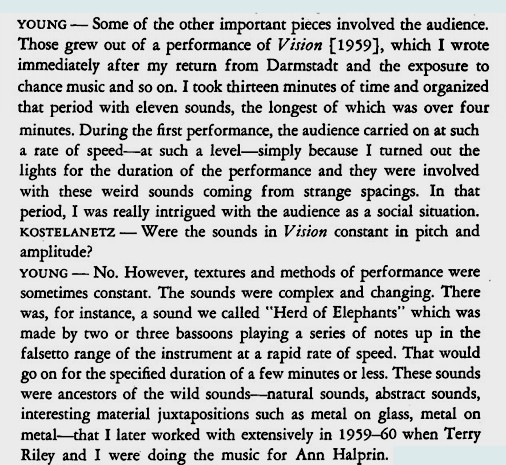  | Conversation With La Monte Young By Richard Kostelanetz, 1968. In Richard Kostelanetz. "The Theatre of Mixed Means - An Introduction to Happenings, Kinetic Environments, and Other Mixed-Means Performances". New York : The Dial Press, 1968, pp. 183-218 ; and in La Monte Young/Marian Zazeela," Selected Writings". Munich, Germany: Heinar Friedrich.[5] ref. p. 193 |
Trio for Strings (1958)(Edit)
The Trio for Strings (1958) is based entirely on different spacings and transpositions of selected pitches (usually three at any one time) from the 'dream chord'.
What is more noticeable is that the 48-minute Trio is played entirely without vibrato, mostly pretty quietly and with very slow bowing. The sculptural qualities of the sound are reinforced in performance by the statuesque appearance of the players. The timbres are devoid of colour and the notes are played not 'as individual "parts" but as contributions to a chordal unit whose components are of different durations' (Michael Nyman, Experimental Music (London: Studio Vista, 1974), p. 121.). These chordal units are separated by silences lasting up to 40 seconds.
— Dave Smith, "Following a Straight Line: La Monte Young", Originally published in Contact no. 18 (Winter 1977-78), pp. 4-9. — http://www.users.waitrose.com/~chobbs/smithyoung.html
Le Trio for Strings, qui est un jalon important dans l'histoire de la musique occidentale, est entièrement constitué de longues durées. C'est la composition sérielle la plus étrangement unique que je connaisse. Le son de la pièce, qui combine la patience de la Chine ancienne avec l'austérité du Zen japonais, est dominé par des suspensions d'intervalles qui nous entraînent sur des plans statiques que nos idéaux occidentaux, matérialistes et limités par la pesanteur, ne nous permettent généralement pas d'atteindre.
— Terry Riley, cité in Edward Strickland, "Minimalism: Origins", Bloomington & Indianapolis, Indiana University Press, 1993, p.69.

|
LA MONTE YOUNG TRIO FOR STRINGS |
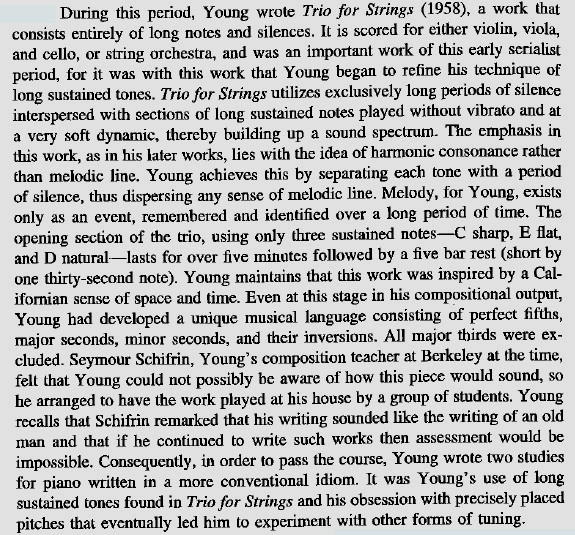 | Ruth Lee Martin,, 'La Monte Young'. In Music of the avant-garde. New York : Greenwood Press, 2002 |
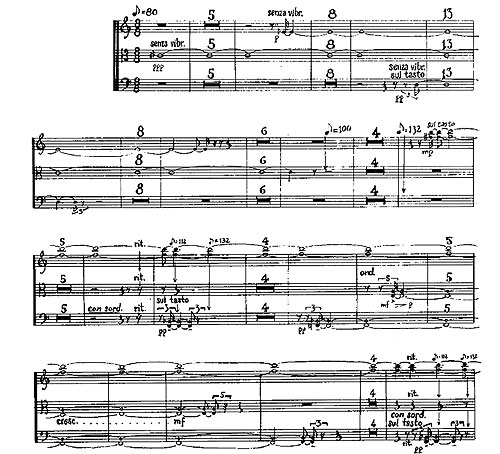 Source : http://www.paristransatlantic.com/magazine/interviews/curtis.html |
Five Small Pieces for String Quartet (On Remembering a Naiad), for string quartet (1956)(Edit)
1. A Wisp, 2. A Gnarl, 3. A Leaf, 4. A Twig, 5. A Tooth.
(Arditti Quartet) (cd : Paris : Naïve, 2001)
(La vidéo documentaire n'est plus accessible sur Youtube / The video document is not yet available on Youtube)
WORKS : List (1985-2005)(Edit)
- 1988, The Big Dream Symmetries, n° 1-6, environnements sonores;
- 1989, The Symmetries in Prime Time from 144 to 112 with 119, comprenant : « The Close Position Symmetry, The Symmetry Modeled on BDS # 1» , « The Symmetry Modeled on BDS # 4 », « The Symmetry Modeled on BDS # 7 », « The Romantic Symmetry », « The Romantic Symmetry » (over la 60 cycle base), « The Great Romantic Symmetry », environnements sonores;
- 1989-1990, The Lower Map of The Eleven's Division in The Romantic Symmetry (over e 60 cycle base) in Prime Time from 144 to 112 with 119 (1989-1990), instruments indéfinies et environnement sonore.
- 1989-1990, The Prime Time Twins, comprenant : «The Prime Time Twins in The Ranges 144 to 112; 72 to 56 et 38 to 28 » Including « The Special Primes 1 et 2 »
- 1990, The Prime Time Twins en The Ranges 576 to 448 ; 288 to 224 ; 144 to 112 ; 72 to 56 ; 36 to 28 ; with The Range Limits 576, 448, 288, 224, 144, 56 et 28, environnements sonores
- 1990, Chronos Kristalla, pour quatuor à cordes
- 1991, The Young Prime Time Twins, comprenant : « The Young Prime Time Twins in The Ranges 2304 to 1792 ; 1152 to 896 ; 576 to 448 ; 288 to 224 ; 144 to 112 ; 72 to 56 ; 36 to 28 ; Including ou Excluding The Range Limits 2304, 1792, 1152, 576, 448, 288, 224, 56 et 28 »
- 1991, The Young Prime Time Twins in The Ranges 2304 to 1792 ; 1152 to 896 ; 576 to 448 ; 288 to 224 ; 144 to 112 ; 72 to 56; 36 to 28 ; 18 to 14 ; Including ou Excluding The Range Limits 2304, 1792, 1152, 576, 448, 288, 224, 56, 28 et 18 ; et Including The Special Young Prime Twins Straddling The Range Limits 1152, 72 et 18
- 1991, The Young Prime Time Twins in The Ranges 1152 to 896 ; 576 to 448 ; 288 to 224 ; 144 to 112 ; 72 to 56 ; 36 to 28 ; Including ou Excluding The Range Limits 1152, 576, 448, 288, 224, 56 et 28 ; with One of The Inclusory Optional Bases : 7 ; 8 ; 14:8 ; 18:14:8 ; 18:16:14 ; 18:16:14:8 ; 9:7:4 ; ou The Empty Base, pour environnements sonores
- 1991-..., The Symmetries in Prime Time from 288 to 224 with 279, 261 et 2 X 119 with One of The Inclusory Optional Bases : 7 ; 8 ; 14:8 ; 18:14:8 ; 18:16:14 ; 18:16:14:8 ; 9:7:4 ; ou The Empty Base. Comprenant : The Symmetries in Prime Time When Centered above et below The Lowest Term Primes in The Range 288 to 224 with The Addition of 279 et 261 in Which The Half of The Symmetric Division Mapped above et Including 288 Consists of The Powers of 2 Multiplied by The Primes within The Ranges of 144 to 128, 72 to 64 et 36 to 32 Which Are Symmetrical to Those Primes in Lowest Terms en The Half of The Symmetric Division Mapped below et Including 224 within The Ranges 126 to 112, 63 to 56 et 31.5 to 28 with The Addition of 119 et with One of The Inclusory Optional Bases: 7; 8; 14:8; 18:14:8; 18:16:14; 18:16:14:8; 9:7:4; ou The Empty Base (1991), pour environnements sonores
- 1953-1955 ; 1992, Annod, 92 X 19 Version, for Zeitgeist (pour l'esprit du temps), pour saxophone alto, vibraphone, piano, basse, batterie, comprenant : « 92 XII 22 Two-Part Harmony » et « XII Annod Backup Riffs » (1992);
- 2002-2003, Just Charles & cello in The Romantic Chord, pour violoncelle, bourdonnements de violoncelle enregitré, et jeu de lumières
- 2002-...., Raga Sundara, vilampit khayal set en Raga Yaman Kalyan, voix, divers instruments, bourdonnement de tampura
- 1984-2001-2005(1958), Trio pour cordes, version en intonation juste, pour 2 violoncelles, 2 violons, 2 altos
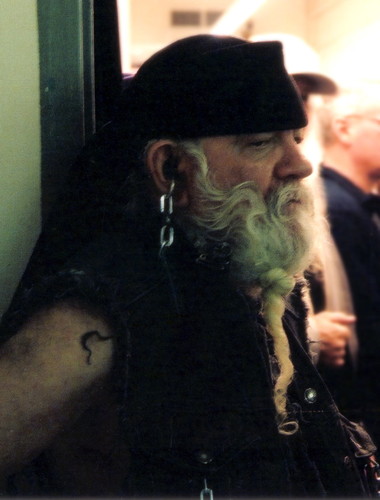 credits : Jung Hee Choi | 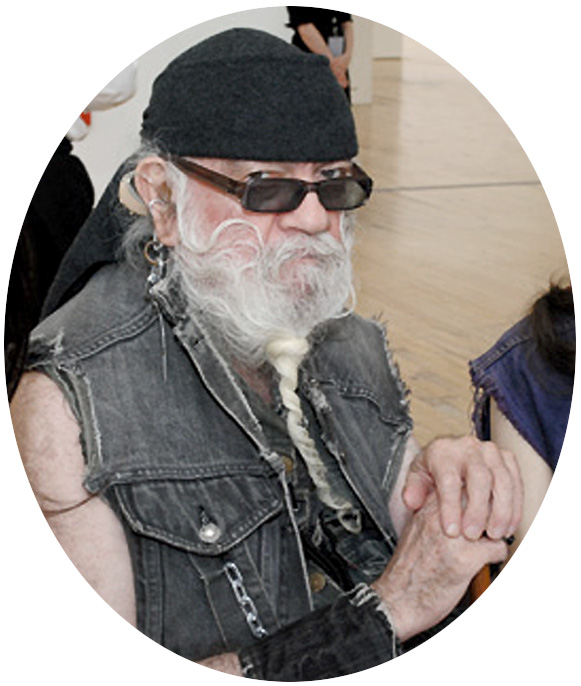 |

